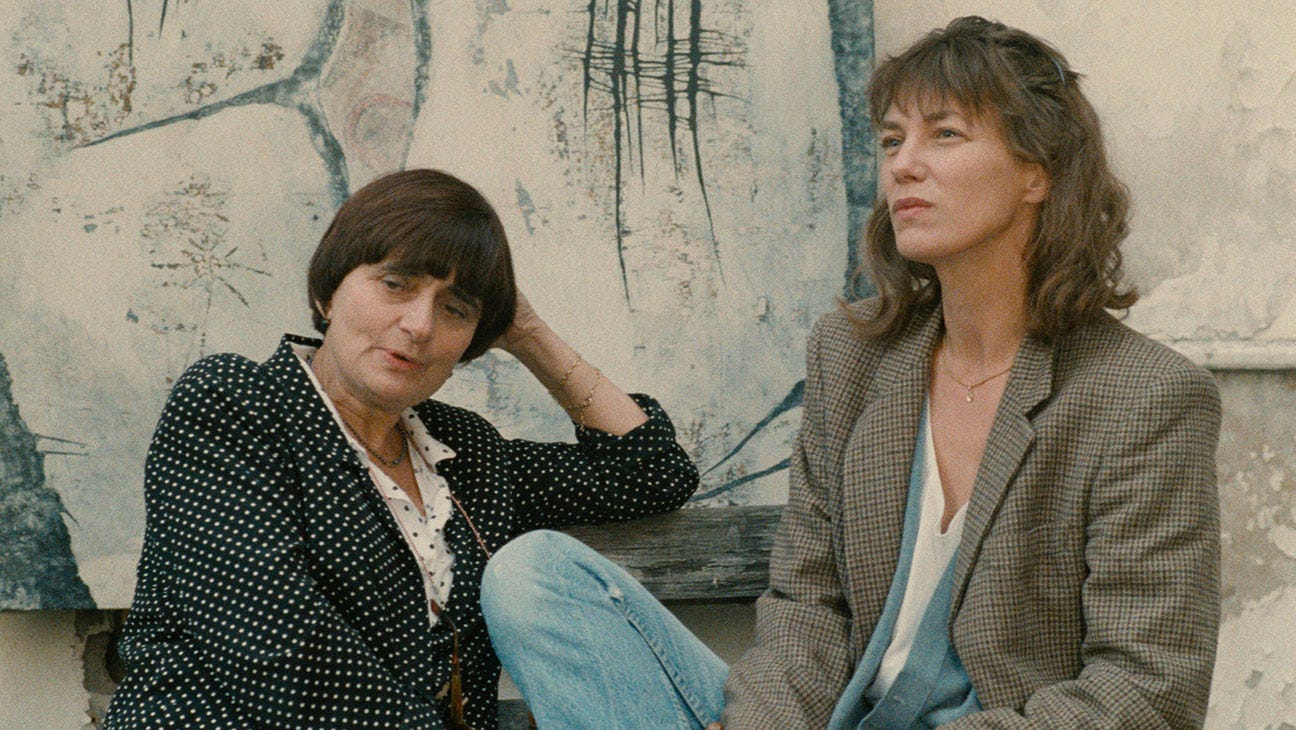Jane B. par Agnès V. is a portrait of life not as it was, but as seen from someone who loves you. Loved everything about you to the point of total adoration. It’s a portrait without the world, and years, interrupting. Birkin wrote to Varda in emotional script, help, but Varda could not read it. She asked her to come, sit in her kitchen, tell her what it is. B. said she did not want to turn forty. In the opening frame, a woman with perfect breasts stands to the left, a headpiece made of jewels hangs between her eyes, a yellow flower in her hand. On the right, another woman in a long, red skirt, her hands knit together holding herself. Birkin sits in the middle and remembers turning thirty in London, away from her children. She drank sherry. It was so sweet it made her ill. This image is very calm, timeless…motionless. Yet you can sense time passing, drop by drop. Every minute… every second…weeks…years. Next B. is filmed walking across a busy intersection. She’s lit up by Christmas decorations, the headlight of the camera. She’s forty, but the scene harks back to an earlier B. caught in the magnificence that brought her to forty still worthy of the camera’s affection. Twenty-four portraits occur every second of the film and so, it’s only as real as anything cut at just the right moment, stalled to hang in imagination—beauty both the driver and the concern. Varda and Birkin meet in a coffee shop. V. is on the other side, showing herself to the camera. B. is late, breezing in all charm and effervescence. What to do next, B. says with her body. She is always pleasing. All V. asks is that B. look directly into the hole of the camera as often as she can, otherwise you’re not looking at me. Anything positioned just right can be beautiful. Head on, less so, and B. knows this. Still she says, I don’t care what you do with me, as long as I feel you like me. Later, V. asks B. whether she thinks she could act as just anyone and B. says yes. She says she would like to be filmed as if transparent, anonymous. In Cindy Sherman’s portrait project Bus Riders, Sherman dresses as different characters, waits for the bus, and takes photographs. Legacy Russell notes that her white characters result with nuance while her Black subjects are flat. Where are the sonic and haptic frequencies of blackness, the static hiss at top volume, a droning psyop of noise that both disorients and distracts, to move beyond the aesthetic toward listening? This is what B. wants: a distinct depth that is beauty itself. Instead poor, middle aged B. sets flies to the young woman with the yellow flower lying naked on a daybed. They devour her, though she remains unaffected. The background subjects freeze as the frame fills with flies. Such an image emits something permanent that repeats in the mind. Like the woman of V.’s youth drowned in the Seine. She was so beautiful a death mask was made. Plaster copies were produced, “The Unknown Woman of the Seine.” No one knew anything about her and so everyone could fantasize about her. She was an incredible nobody. Most memorable was her indeterminate facial expression: at peace and pleased. Had she been happy to die? Living rooms and hallways of Paris lined with her face, V. says: I wonder if the only true portrait is the death mask. I think of another such image outside the screen: a purple sky, pink flares, and billowing gray plumes of smoke. Somewhere in Beirut beneath the purple, to the East, is an apartment. Inside are two men. One holds a sewing pin in his mouth, the other something to smoke. The apartment is bare, what furniture it has is covered in white cloth. To the side of the frame, a mannequin wears an astonishing garment—square shoulders, a sharp neckline—made for a bride. The man smoking sends a message across countries that reads: I’m safe, I’m scattered, I love you so much. It is an image that withstands attention because it appears beautiful, but is not.

A few things…
This is the last unpaid entry of Intertext for now (but a free thing might be sent here and there). To continue reading, you’ll need to be a paid subscriber. If cost is an issue, please reach out. I have the ability to comp subscriptions and I’m happy to do it.
These essays will continue on a bimonthly cadence and by late October/early November I’ll start sharing chats with writers and artists about the writers and artists influencing their work and thinking. The Substack App is honestly very good and I want to recommend it for the audio function especially. It turns all of the text here into, basically, a podcast without me having to do anything. Hurray.
Thanks, always, for reading. <3
Notes
Jane B. par Agnès V. Directed by Agnès Varda. France: Ciné Tamaris, 1988.
Legacy Russell, Black Meme. New York: Verso Books, 2023.





